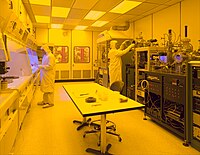
Photo from wikipedia
Seeking sensitive, large-scale, and low-cost substrates is highly important for practical applications of surface-enhanced Raman scattering (SERS) technology. Noble metallic plasmonic nanostructures with dense hot spots are considered an effective… Click to show full abstract
Seeking sensitive, large-scale, and low-cost substrates is highly important for practical applications of surface-enhanced Raman scattering (SERS) technology. Noble metallic plasmonic nanostructures with dense hot spots are considered an effective construction to enable sensitive, uniform, and stable SERS performance and thus have attracted wide attention in recent years. In this work, we reported a simple fabrication method to achieve wafer-scale ultradense tilted and staggered plasmonic metallic nanopillars filled with numerous nanogaps (hot spots). By adjusting the etching time of the PMMA (polymethyl methacrylate) layer, the optimal SERS substrate with the densest metallic nanopillars was obtained, which possessed a detection limit down to 10−13 M by using crystal violet as the detected molecules and exhibited excellent reproducibility and long-term stability. Furthermore, the proposed fabrication approach was further used to prepare flexible substrates; for example, a SERS flexible substrate was proven to be an ideal platform for analyzing low-concentration pesticide residues on curved fruit surfaces with significantly enhanced sensitivity. This type of SERS substrate possesses potential in real-life applications as low-cost and high-performance sensors.
Journal Title: Nanomaterials
Year Published: 2023
Link to full text (if available)
Share on Social Media: Sign Up to like & get
recommendations!